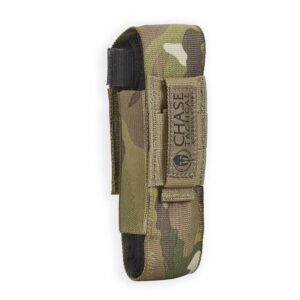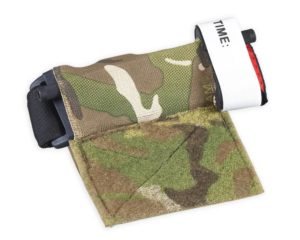Difference Between a Tourniquet and a Bandage

When it comes to basic first aid, tourniquets and bandages are both essential, but they serve distinct roles. At first glance, they might look alike, but their functions, how you apply a tourniquet and bandage, and the situations in which you use them are quite different.
In this article, we’ll explore the key differences between a tourniquet and a bandage, the various types available, how to use them properly, and when to choose one over the other. Ensure operational readiness and equip with Chase Tactical Medical Essentials.
Bandage vs Tourniquet
Bandages are usually for everyday injuries, sports accidents, or general wound care. You’ll find them in homes, schools, and first-aid kits, and they’re safe to use without any medical training.
Tourniquets are emergency tools designed for use in life-threatening situations. Use them only after an accident or in cases of heavy bleeding when other methods haven’t worked. They require careful application, as misuse can cause tissue or nerve damage.
Think of a bandage as your go-to for healing, while a tourniquet is your lifesaver in critical situations. Knowing how to distinguish between them can make all the difference when you need to act quickly, whether you’re covering a small cut or trying to stop severe bleeding until professional help arrives.
Usage of Bandages

Bandages are remarkably versatile and can be applied to a wide range of medical conditions. Their primary function is to dress wounds, hold dressings in place, compress swellings, and immobilize strained or sprained muscles and joints.
For example, if one has a deep arm cut, a Chase Tactical gauze pad should be applied over the wound, and a bandage may be tied around it to keep the area clean and covered. Elastic bandages are best used for wrapping the ankles, knees, or wrists to exert compression and decrease swelling following a strain or sprain.
Moreover, bandages help minimize the risk of infection by covering open wounds and protecting them from contamination. Adhesive bandages, also known as “band-aids,” are ideal for small cuts, while larger or more severe wounds require gauze and a firm wrap. In all cases, it’s important to apply the bandage snugly but not so tightly that it restricts blood flow. Bandages are also reusable or disposable, depending on the type and setting.
Usage of Tourniquets

Tourniquets, on the other hand, are used only when there’s serious bleeding that cannot be controlled by pressure alone. Their function is to stop the flow of blood to a limb, thereby preventing further blood loss.
Tourniquets are typically applied a few inches above the injury site, between the wound and the heart. For example, in a car accident or on a battlefield, a tourniquet might be the only way to keep someone alive until paramedics arrive.
It’s essential to obtain a high-quality tourniquet, such as the Chase Tactical CAT Tourniquet GEN 7, and apply it correctly, as misuse can lead to serious injury. After application, ensure that you record the time and get immediate medical help. Tourniquets are intended to be temporary and should be applied only as a last resort in life-threatening situations.
How to Apply a Bandage
Applying a bandage depends on the type of injury.
For wounds
- First, clean the area
- Then place a sterile dressing and wrap the bandage snugly—but not too tightly.
For support
- Wrap the bandage around the joint or limb using overlapping turns. Always check that blood circulation is not restricted.
How to Apply a Tourniquet
- Place it 2–3 inches above the bleeding site
- Tighten it until the bleeding stops.
- If the bleeding doesn’t stop, tighten it further or apply a second tourniquet above the first.
Always note the time it was used and seek immediate medical help—tourniquets are only a temporary solution.
Difference Between a Tourniquet and a Bandage

Though both are essential in first-aid care, a tourniquet and a bandage serve different purposes. A tourniquet is meant to stop heavy bleeding by cutting off circulation, while a bandage protects wounds and supports injuries without restricting blood flow.
1. Functioning
A tourniquet is used to completely stop blood flow in cases of severe, life-threatening bleeding. A bandage, on the other hand, is used to support, protect, or compress a wound or injury without cutting off blood circulation.
2. Application
Tourniquets must be applied with precision and care, typically by trained individuals. Bandages are easier to use and can be applied by anyone with basic first-aid knowledge.
3. Effect on Blood Circulation
A tourniquet completely restricts blood flow. Should not be left on for long due to the risk of tissue damage. A bandage allows some circulation. If used for compression, it should reduce swelling or bleeding without cutting off blood flow.
4. Situational Use
Tourniquets are used in emergencies, particularly when immediate control of blood loss is necessary. Bandages are used for both minor and moderate injuries to provide everyday treatment and support.
5. Materials
Tourniquets are made of strong materials, such as rubber, nylon, or fabric, with a windlass for tightening. Bandages are made of cotton, gauze, elastic, or crepe fabric.
6. Duration of Use
Tourniquets are only used for a short period to prevent tissue damage, usually until medical help arrives. Bandages can be worn for hours or days, depending on the severity of the injury.
Conclusion
While both tourniquets and bandages are essential in first aid, their purposes are very different. A tourniquet is a critical tool for stopping severe bleeding in emergencies, while a bandage is ideal for everyday injuries and support.
Understanding how and when to use each can make all the difference in an emergency. Always keep both in your first-aid kit and learn how to use them properly—it could save a life.
Frequently Asked Questions
Can a bandage be used as a tourniquet?
In extreme emergencies, a bandage can be used to improvise a tourniquet, but it’s not ideal. Always use a proper tourniquet if available.
How long can a tourniquet be left on?
A tourniquet should not be left in place for more than 2 hours. After that, it may cause permanent damage to the tissue.
What is the risk of using a tourniquet incorrectly?
Improper use can cause nerve damage, tissue death, or increased bleeding. Only use it when necessary.
Are all bandages safe for open wounds?
Not all. Always use sterile bandages for open wounds to avoid infection.
Should I include a tourniquet in my first aid kit?
Yes, especially if you hike, camp, or work in a high-risk area. It’s a simple tool that could save a life in a critical moment.

